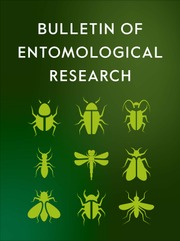Article contents
Shifted phenology in the pine processionary moth affects the outcome of tree–insect interaction
Published online by Cambridge University Press: 13 June 2019
Abstract
In the Mediterranean and temperate regions, an increase in the frequency and intensity of drought events has been recorded, probably due to climate change. In consequence, trees will more frequently experience hydric stress, a condition that can be expected to affect insect–tree interactions, while adaptation mechanisms may be further in course. The effect of tree water stress on the performance of two allochronic populations of Thaumetopoea pityocampa was here studied. Namely, we compared a unique population of this insect, in which the larvae develop in the summer (SP), with the typical population having winter larval development (WP), to test the adaptation hypothesis to host plant status. Larvae of each population were fed on needles of young potted Pinus pinaster plants under two water supply regimes: (i) well-watered (control) and (ii) subjected to 3 months of drought stress. Compared to control, stressed plants had higher amounts of soluble sugars, phenols, and higher C/N ratio, whereas water content and chlorophylls concentrations were lower. In general, T. pityocampa larvae had lower performances on water-stressed plants, as shown by lower survival rates, lower needle consumption, and longer development times. Yet, the detrimental effects of tree stress were only significant for the WP larvae, while SP larvae were able to overcome such conditions. Results demonstrate that tree water stress can negatively affect T. pityocampa populations. Furthermore, the evidence is also provided that responses to the physiological condition of the host trees may occur at the population level, as a result of adaptation mechanisms driven by climate change.
Keywords
- Type
- Research Paper
- Information
- Copyright
- Copyright © Cambridge University Press 2019
References
- 2
- Cited by





